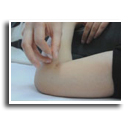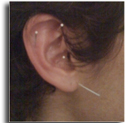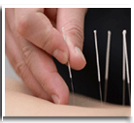|
|


|
 |
To Treat for Sciatica with Acupuncture
The sciatic nerve can literally be a huge pain in the butt. It is the largest nerve in the body, which consists of a large bundle of smaller nerves that begin in the lumbar spine, travel down the buttocks, and move through the leg. Technically, sciatica is not a disease, but a group of symptoms that affect the region of the sciatic nerve. Radiating pain is one of the more common and intense symptoms associated with sciatica. There can also be numbness and tingling starting in the lower back radiating down the leg.
What Causes Sciatica?
Sciatica occurs when something pushes on the sciatic nerve. This can be a muscle spasm, the spinal discs, and sometimes even the spine itself. Most often this pain is due to muscle spasms or a slipped disc, but it can also be a sign of serious illness and it is important to go to you doctor for a diagnosis.
Spinal Disc herniation, often referred to as a slipped disc, is when a small portion of the spinal disc bulges out of the spinal column. This disc then pushes on the sciatic nerve causing pain. In some severe cases, spinal stenosis, or a narrowing of the spinal canal, can push on the nerve and cause pain. Another serious cause of sciatica is spinal tumors, which require immediate medical attention.
Muscle spasms are also a common cause of sciatica. Most often it is the piriformis muscle, but it can be other muscles in the lower back and pelvic region.
What is piriformis syndrome?
The sciatic nerve runs under or, in some people, through the piriformis muscle. This muscle is located in the pelvis. It is connected to the bottom of the spine and the top of the femur, or thighbones. If the piriformis muscle starts to spasm or becomes tight, it can put pressure on the sciatic nerve and cause the pain as well as the radiating symptoms. This persistent spasm of the piriformis muscle is called piriformis syndrome. It can be caused by an injury or sedentary lifestyles in people who don’t stretch or exercise. Particularly if you sit all day at a desk or computer, this can be a problem.
How Does Chinese medicine view sciatica?
Chinese medicine states that the body is interconnected; no one part can be separated from another. The diagnosis and treatment is based upon identifying specific imbalances in the muscles and the body as a whole. Correcting the imbalance does not just treat the symptoms or mask the condition, but rather corrects the root of the problem by encouraging self-healing of the body. The most common imbalance in acute sciatica is qi and blood stagnation in the back channels. But it is also important to treat the underlying imbalance, which may be causing the qi and blood to stagnate.
Qi and blood stagnation in the channels often affects the soft tissue of the lumbar, hips, and pelvis. This is what causes the muscle spasm and tension that triggers the intense shooting pain of acute sciatica.
Some common underlying imbalances are kidney qi vacuity, spleen qi vacuity with dampness, and liver qi stagnation. By treating the underlying imbalance, you can prevent the sciatica from returning.
Kidney Qi Vacuity: If your back feels very weak and it does not get better with a lot of rest, the underlying imbalance may be kidney qi vacuity. Other symptoms include weakness of the knees, extreme fatigue, ringing in the ears, dizziness, and a weak pulse.
Spleen Qi Vacuity with Dampness: For those with spleen qi vacuity with dampness, you will also have fatigue and weakness, but the back feels better with rest. Your body may feel very heavy and you may have poor digestion.
Liver Qi stagnation: Liver qi stagnation causes your muscles to be very tight and in spasm when you become angry or frustrated. Also, you may suffer from frequent headaches and, in women, painful menses.
How Does Chinese medicine Treat Sciatica?
It is best to approach sciatica using combination style treatment. An effective therapy many include acupuncture, Tui Na (Chinese medical massage,) cupping, electric stimulation, and stretching. The back, hip, and pelvis are very interconnected and the treatment should incorporate all of them. Overall, the treatment should relax and stretch the tendons and fascia while strengthening the muscles. This will help release the spastic muscles and strengthen them, allowing the back to naturally heal. It can even encourage an out of place disc to go back into place, depending on severity.
Acupuncture will help to reprogram the muscles to stay relaxed. In effect, this is working to help the body heal itself. Chinese massage, or tui na, works to foster the acupuncture by releasing any extra tension in the fascia and connective tissue around the muscles. The technique called rolling is very important to deeply relax the muscles and improve circulation at the same time.
After the pain is gone, it is important for you to keep up you own back. Stretching is essential. Stretching will help keep the muscles healthy and relaxed. And it is the best way for you to maintain your own back. Also, doing tai chi, the Chinese exercise and meditation, is very effective to strengthen the lower back and relax it.
|
Other Conditions
Commonly Treated by Dr. Zheng
- Hot flashes,
menopause, PMS, irregular menstruation
- Stress, depression, anxiety,
insomnia, fatigue
- Hey-fever, sinusitis, asthma,
bronchitis
- Infertility, impotence
- Dizziness, vertigo, Meniere’s disease
- Hypertension, diabetes, obesity
- Stroke, paralysis, Bell’s palsy
- Indigestion, diarrhea, constipation
- Quitting smoking, beauty &
rejuvenation
SPECIAL SERVICES
- We offer free initial consultation
- We accept health insurance plans
which cover for acupuncture treatment. We may contact
your insurance company to verify your acupuncture
benefits. If you need us to do so, please tell us your
insurance information including your full name,
birthday,insurance ID number, and insurance company’s
Tel. number.
|
|
|




